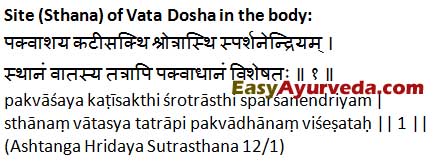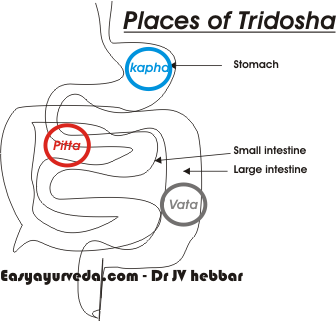Vata Dosha Dominance In Different Body Parts – How it affects health?
The Tridoshas – Vata, Pitta and Kapha are present all over the body. For example, in stomach, Kapha Dosha helps to moisten the food and break it into small pieces, Pitta does the digestion process and Vata ensures proper downward movement of the food particles. But their presence can be especially observed in certain parts of the body. Individual Doshas are more present and more active in specific parts of the body. Let us learn how Vata Dosha is dominant in different areas and how it affects our health.
General rule –
IF you divide the whole body into three parts, the upper one third is dominated by Kapha Dosha, middle one third is dominated by Pitta Dosha and lower one third is dominated by Vata Dosha.

Vata Dosha is located in the following parts of the body –
Pakvashaya – colon
Kati – hips
Sakti – lower limbs
Shrotra – ears
Asthi – bones
Sparshanendriyam – skin
The main location of Vata is Pakvashaya (colon).
Table of Contents
Place of Vata Dosha
Large intestine
At the end of digestion process, after all the nutrients of the food is absorbed by the body, it is sent to large intestines, wherein the Vata helps to further absorb the water and forms the stools. This process is explained as Shoshana in Ayurveda. Shoshana means drying up. It is quite interesting to note that, though Vata functions are compared to motor and sensory functions of the brain, large intestine is the special place of Vata Dosha and not the brain. I am not implying that brain does not contain Vata Dosha. Brain has Vata influence, through which it controls sense organs. But large intestine is its special place. For this reason, Basti treatment (enema therapy) is used extensively in all Vata related disorders (including neurological conditions).
Waist and hip
Wherever there is a nerve plexus (a bunch of nerve root origins chained together), there is Vata dominance. At the waist / lower back we have lumbar nerve plexus, from where, nerves arise and spread to both legs. By this nerve plexus, Vata controls all the sensory and motor actions of the legs. Also, all the excretory organs are present at the waist. Hence, Vata regulates the process of defecation, ejaculation, ovulation, menstruation and child birth.
Ear
Wherever there is vacuum or air, there is a presence of Vata, as Vata is formed by air and vacuum. Hence, ear is a special place of Vata, though Vata controls all the other sense organs as well.
Bones
Bone tissue is dominant with Vata. Hence, all the degenerative bone and joint disorders that affect our health at old age are due to Vata. (old age is again dominant with Vata.)
Skin
Vata carries signals from the skin to the brain and vice versa.
Thus Vata controls all the sensory and motor functions of the body.
Urinary system
Waste product excretion is a Vata activity. Vata, dominating the lower part of the body also signifies its presence in kidney and urinary bladder.
Vata is also present in uterus and is responsible for periods and child birth.
Waist, thigh and lower limbs
These are special places of Vata. Hence, osteo-arthritis – which is purely a vata disorder often affects the joints in these areas.
Related post –
Easiest way to understand Tridosha
Vata Dosha Imbalance symptoms
My Tridosha ebook –
Hip, lower back and Vata Dosha
Why is the hip and below region explained as a Vata dominant place?
Dr JV Hebbar
The lower abdomen and below area is explained as being dominated by Vata Dosha.
Chala – Movement, is a quality of Vata Dosha. Vata is responsible for all the movements in the body.
Bones and joints are also places for Vata Dosha, as they are involved in locomotion.
Read: Vata Dosha – Introduction, 40 Things To Know
The lower abdomen and hip region is a complex area with joints formed by back bones, hip bones and the thigh bones.
The lower abdomen is also the area in which excretory organs such as anal canal, kidney, urinary bladder, urethra are present.
It is the area where organs of the reproductive system are present. The movement of urine, feces, semen, ovum, menstrual flow – all these are regulated by Vata Dosha.
Due to all these reasons, the lower one third of the body is dominated by Vata Dosha.
When a person ages, the Vata Dosha increases and bone density decreases.
Consider Vata Dosha as air. When the air volume increases, the bones become more porous and joints become dry, they lack cushioning and they become weak.
This is the reason why, arthritis, osteoporosis (bones becoming porous and weak) affects lower back, hip and the knee joints the most.
This is the reason why elderly people suffer with low back and knee pain due to arthritis.
Read: OsteoArthritis Symptoms, Prevention, Lifestyle tips
How to keep the Vata in a balanced state?
Nutritious diet – Nourishes all the body tissues. If the body tissues are well nourished, Vata will be under control. (Contrary to this, if the tissues are degenerating, as in old age, Vata Dosha increases).
Healthy amount of exercise – Dominated by Yoga, helps to improve the flexibility and strength of bones.
Regular Oil Massage – Full body massage or at least to hips, lower back and knees with Maha Narayana taila.
Read: Abhyanga – Ayurvedic Massage: How To Do? Benefits, Right Oils












6 comments
purushotham shedambi
Liked it and understood
savvy
Hi doc.I had repeated usg of abdomen but never came to know the exact reason.even super natural treatments were given.tnx to that one universal energy,that brought me to ur site.all my doubts r clear due to your letters.vata dosh.now I have conquered it.
Dr J V Hebbar MD(Ayu)Author
And thanks to that universal energy that prompted you to let me know that you were benefited by my service. 🙂
Anupriya
Hello doctor . After reading this article I am sure my problem is mostly (if not all) vata dosha . My ears ring. Urinary problems, skin sensitive, stools are not well formed and slow mind . Everything Hot in potency suits me very well . Anything which is cooling makes my condition worse . Am currently using raw crushed garlic after every meal and fenugreek powder early morning . Can you guide sone more home remedies for me to balance my system ? If I don’t take garlic , I feel very cold even if it is 40 degrees outside . Hoping to get done guidance
Dr J V Hebbar MD(Ayu)Author
Please read here – https://www.easyayurveda.com/2010/05/19/ayurveda-vata-diet/
Sarbjit kaur
Hello Doctor muje vaata imbalance Ki problem hai an getting worse kya aap muje plz koi medicine ya syrup bata sakte hai plz help me an give me suggestions plz I got joint pain problems dry an itchi skin , pigmentation cracked heels gas ki problem bot worst hai whatever I eat gas ban Jati hai plz Doc help me. Thanks